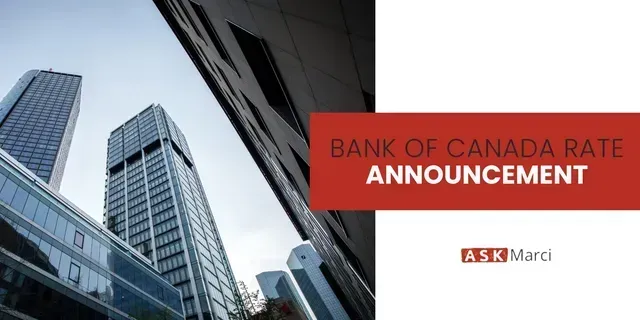Bank of Canada Rate Announcement Jan 9th, 2019
The Bank of Canada today maintained its target for the overnight rate at 1 ¾ per cent. The Bank Rate is correspondingly 2 per cent and the deposit rate is 1 ½ per cent.
The global economic expansion continues to moderate, with growth forecast to slow to 3.4 per cent in 2019 from 3.7 per cent in 2018. In particular, growth in the United States remains solid but is expected to slow to a more sustainable pace through 2019. However, there are increasing signs that the US-China trade conflict is weighing on global demand and commodity prices.
Global benchmark prices for oil have been about 25 per cent lower than assumed in the October Monetary Policy Report (MPR). The lower prices primarily reflect sustained increases in US oil supply and, more recently, increased worries about global demand. These worries among market participants have also been reflected in bond and equity markets.
The drop in global oil prices has a material impact on the Canadian outlook, resulting in lower terms of trade and national income. As well, transportation constraints and rising production have combined to push up oil inventories in the west and exert even more downward pressure on Canadian benchmark prices. While price differentials have narrowed in recent weeks following announced mandatory production cuts in Alberta, investment in Canada’s oil sector is projected to weaken further.
These developments are occurring in the context of a Canadian economy that has been performing well overall. Growth has been running close to potential, employment growth has been strong and unemployment is at a 40-year low. Looking ahead, exports and non-energy investment are projected to grow solidly, supported by foreign demand, the CUSMA, the lower Canadian dollar, and federal tax measures targeted at investment.
Meanwhile, consumption spending and housing investment have been weaker than expected as housing markets adjust to municipal and provincial measures, changes to mortgage guidelines, and higher interest rates. Household spending will be dampened further by slow growth in oil-producing provinces. The Bank will continue to monitor these adjustments.
The Bank projects real GDP will grow by 1.7 per cent in 2019, 0.4 percentage points slower than the October outlook. This revised forecast reflects a temporary slowing in the fourth quarter of 2018 and the first quarter of 2019. This will open up a modest amount of excess capacity, primarily in oil-producing regions. Nevertheless, indicators of demand should start to show renewed momentum in early 2019, leading to above-potential growth of 2.1 per cent in 2020.
Core inflation measures remain clustered close to 2 per cent. As expected, CPI inflation eased to 1.7% in November, due to lower gasoline prices. CPI inflation is projected to edge further down and be below 2 per cent through much of 2019, owing mainly to lower gasoline prices. On the other hand, the lower level of the Canadian dollar will exert some upward pressure on inflation. As these transitory effects unwind and excess capacity is absorbed, inflation will return to around the 2 per cent target by late 2019.
Weighing all of these factors, Governing Council continues to judge that the policy interest rate will need to rise over time into a neutral range to achieve the inflation target. The appropriate pace of rate increases will depend on how the outlook evolves, with a particular focus on developments in oil markets, the Canadian housing market, and global trade policy.
Information note
The next scheduled date for announcing the overnight rate target is March 6, 2019. The next full update of the Bank’s outlook for the economy and inflation, including risks to the projection, will be published in the MPR on April 24, 2019.
The remaining announcement dates in 2019 are as follows:
- March 6th 2019
- April 24th 2019*
- May 29th 2019
- July 10th 2019*
- September 4th 2019
- October 30th 2019*
- December 4th 2019
* Monetary Policy Report published
To read the Bank of Canada Monetary Policy Report for January 9th 2019, click here.
Share












